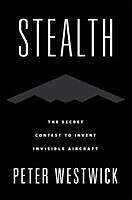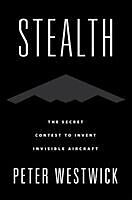Stealth
Einband:
Fester Einband
EAN:
9780190677442
Untertitel:
The Secret Contest to Invent Invisible Aircraft
Genre:
Geschichte
Autor:
Peter Westwick
Herausgeber:
Oxford Academic
Anzahl Seiten:
272
Erscheinungsdatum:
09.04.2020
ISBN:
978-0-19-067744-2
Zusatztext This concise, highly readable history of the creation, development, and application of one of the most important technologies of the Cold War brings clarity and a thorough understanding to this complex subject. Informationen zum Autor Peter Westwick is a research professor of history at the University of Southern California and director of the Aerospace History Project at the Huntington-USC Institute on California and the West. He is the author or editor of several books, including Into the Black: JPL and the American Space Program, 1976-2004, which won book prizes from the American Institute of Aeronautics and Astronautics and the American Astronautical Society. Klappentext The story of the technology that revolutionized aeronautics and changed modern warfare Zusammenfassung On a moonless night in January 1991, a dozen U.S. aircraft appeared in the skies over Baghdad. To the Iraqi air defenses, the planes seemed to come from nowhere. Their angular shape, making them look like flying origami, rendered them virtually undetectable. Each aircraft was more than 60 feet in length and with a wingspan of 40 feet, yet its radar footprint was the size of a ball bearing. Here was the first extensive combat application of Stealth technology. And it was devastating. Peter Westwick's new book illuminates the story behind these aircraft, the F-117A, also known as the Stealth Fighter, and their close cousin the B-2, also known as the Stealth Bomber. The development of Stealth unfolded over decades. Radar has been in use since the 1930s and was essential to the Allies in World War Two, when American investment in radar exceeded that in the Manhattan Project. The atom bomb ended the war, conventional wisdom has it, but radar won it. That experience also raised a question: could a plane be developed that was invisible to radar? That question, and the seemingly impossible feat of physics and engineering behind it, took on increasing urgency during the Cold War, when the United States searched for a way both to defend its airspace and send a plane through Soviet skies undetected. Thus started the race for Stealth. At heart, Stealth is a tale of not just two aircraft but the two aerospace companies that made them, Lockheed and Northrop, guided by contrasting philosophies and outsized personalities. Beginning in the 1970s, the two firms entered into a fierce competition, one with high financial stakes and conducted at the highest levels of secrecy in the Cold War. They approached the problem of Stealth from different perspectives, one that pitted aeronautical designers against electrical engineers, those who relied on intuition against those who pursued computer algorithms. The two different approaches manifested in two very different solutions to Stealth, clearly evident in the aircraft themselves: the F-117 composed of flat facets, the B-2 of curves. For all their differences, Lockheed and Northrop were located twenty miles apart in the aerospace suburbs of Los Angeles, not far from Disneyland. This was no coincidence. The creative culture of postwar Southern California-unorthodox, ambitious, and future-oriented-played a key role in Stealth. Combining nail-biting narrative, incisive explanation of the science and technology involved, and indelible portraits of unforgettable characters, Stealth immerses readers in the story of an innovation with revolutionary implications for modern warfare. Inhaltsverzeichnis Chapter 1. Roots of the Revolution Chapter 2. Dark Days in the Sunshine State Chapter 3. Breeding Invisible Rabbits Chapter 4. Lockheed: Tin Shed in a Hurricane Chapter 5. Northrop: Seeing the Waves Chapter 6. Shootout at RATSCAT Chapter 7. Have Blue and the F-117 Chapter 8. Secrets and Strategies Chapter 9. The Whale Chapter 10. Winning the B-2 Chapter 11. Building the B-2 Chapter 12. Stealth and the Modern Military ...
Autorentext
Peter Westwick is a research professor of history at the University of Southern California and director of the Aerospace History Project at the Huntington-USC Institute on California and the West. He is the author or editor of several books, including Into the Black: JPL and the American Space Program, 1976-2004, which won book prizes from the American Institute of Aeronautics and Astronautics and the American Astronautical Society.
Klappentext
The story of the technology that revolutionized aeronautics and changed modern warfare
Zusammenfassung
On a moonless night in January 1991, a dozen U.S. aircraft appeared in the skies over Baghdad. To the Iraqi air defenses, the planes seemed to come from nowhere. Their angular shape, making them look like flying origami, rendered them virtually undetectable. Each aircraft was more than 60 feet in length and with a wingspan of 40 feet, yet its radar footprint was the size of a ball bearing. Here was the first extensive combat application of Stealth technology. And it was devastating. Peter Westwick's new book illuminates the story behind these aircraft, the F-117A, also known as the Stealth Fighter, and their close cousin the B-2, also known as the Stealth Bomber. The development of Stealth unfolded over decades. Radar has been in use since the 1930s and was essential to the Allies in World War Two, when American investment in radar exceeded that in the Manhattan Project. The atom bomb ended the war, conventional wisdom has it, but radar won it. That experience also raised a question: could a plane be developed that was invisible to radar? That question, and the seemingly impossible feat of physics and engineering behind it, took on increasing urgency during the Cold War, when the United States searched for a way both to defend its airspace and send a plane through Soviet skies undetected. Thus started the race for Stealth. At heart, Stealth is a tale of not just two aircraft but the two aerospace companies that made them, Lockheed and Northrop, guided by contrasting philosophies and outsized personalities. Beginning in the 1970s, the two firms entered into a fierce competition, one with high financial stakes and conducted at the highest levels of secrecy in the Cold War. They approached the problem of Stealth from different perspectives, one that pitted aeronautical designers against electrical engineers, those who relied on intuition against those who pursued computer algorithms. The two different approaches manifested in two very different solutions to Stealth, clearly evident in the aircraft themselves: the F-117 composed of flat facets, the B-2 of curves. For all their differences, Lockheed and Northrop were located twenty miles apart in the aerospace suburbs of Los Angeles, not far from Disneyland. This was no coincidence. The creative culture of postwar Southern California-unorthodox, ambitious, and future-oriented-played a key role in Stealth. Combining nail-biting narrative, incisive explanation of the science and technology involved, and indelible portraits of unforgettable characters, Stealth immerses readers in the story of an innovation with revolutionary implications for modern warfare.
Inhalt
Chapter 1. Roots of the Revolution
Chapter 2. Dark Days in the Sunshine State
Chapter 3. Breeding Invisible Rabbits
Chapter 4. Lockheed: Tin Shed in a Hurricane
Chapter 5. Northrop: Seeing the Waves
Chapter 6. Shootout at RATSCAT
Chapter 7. Have Blue and the F-117
Chapter 8. Secrets and Strategies
Chapter 9. The Whale
Chapter 10. Winning the B-2
Chapter 11. Building the B-2
Chapter 12. Stealth and the Modern Military

Leider konnten wir für diesen Artikel keine Preise ermitteln ...
billigbuch.ch sucht jetzt für Sie die besten Angebote ...
Die aktuellen Verkaufspreise von 6 Onlineshops werden in Realtime abgefragt.
Sie können das gewünschte Produkt anschliessend direkt beim Anbieter Ihrer Wahl bestellen.
Loading...
Die aktuellen Verkaufspreise von 6 Onlineshops werden in Realtime abgefragt.
Sie können das gewünschte Produkt anschliessend direkt beim Anbieter Ihrer Wahl bestellen.
| # | Onlineshop | Preis CHF | Versand CHF | Total CHF | ||
|---|---|---|---|---|---|---|
| 1 | Seller | 0.00 | 0.00 | 0.00 |
